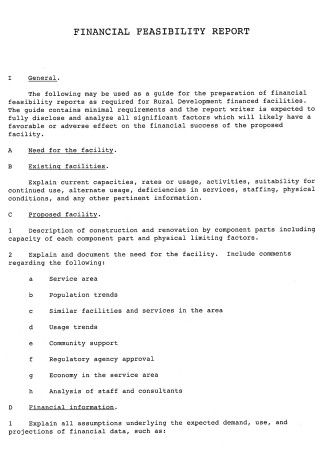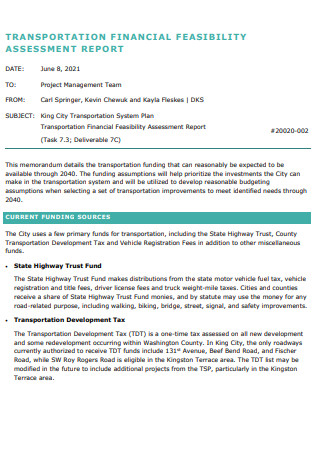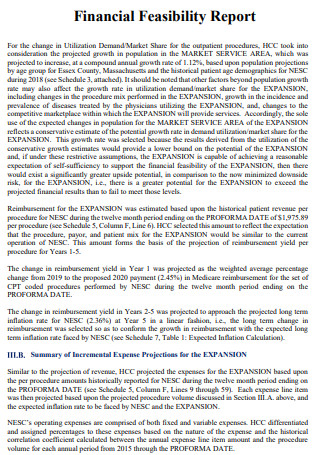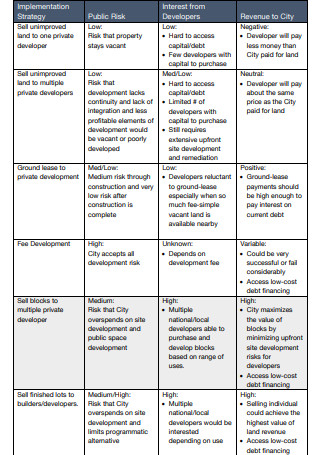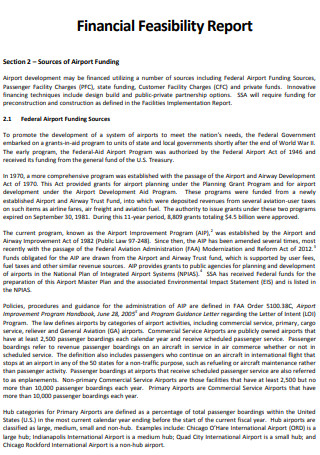4+ SAMPLE Financial Feasibility Report
What Is a Financial Feasibility Report?
A financial feasibility report evaluates the financial elements of a proposed project, investment, or other endeavors. It considers various factors, including capital, expenses, revenues, investment income, and expenditures, to generate a more thorough report. Financial feasibility studies answer the question, “Will the project or firm has sufficient funds to complete the project and create a profit?” Every firm must know if it can maintain itself, pay its staff, and still produce enough money to turn a profit. This type of feasibility study is created for a corporation or business that wishes to assess its financial capabilities and determine if it has the capital required to assure the success of its project. Statistics indicate that the project success rate has increased with time. In 2016, 62% of initiatives reached their initial commercial objectives, while only 50% were completed under budget. In 2018, the respective percentages rose to 70% and 60%.
Elements of a Feasibility Report
A feasibility study compiles crucial company data and encourages investors, company leaders, and other company personnel to support a project. Consider including the following components of a feasibility report on your own:
Types of Feasibility Reports
The most successful businesses have lofty objectives. Expansion needs testing and risk, whether you are introducing a new product or entering a new industry. It occasionally necessitates undertaking projects or initiatives without knowing precisely how they will manifest or whether they will ultimately benefit the organization. Consequently, there are five types of feasibility studies, each of which provides a unique lens through which you can analyze the viability of your company idea or project:
Tips to Evaluate a Company Project
Evaluation of projects is a method for determining the success and impact of projects, initiatives, and policies. It needs the evaluator to collect pertinent data to examine the process and results of a particular project. Project evaluation inspires improvements in the internal circle, identifies patterns among the project’s intended audience, informs future project planning, and communicates the value of completed projects to external stakeholders. Evaluation of a project includes preparation and implementation. Listed below are the steps necessary to evaluate your project:
1. Develop an evaluation strategy
As you construct your project, create goals and objectives to provide structure and a clear direction for your team. These objectives and goals also help you select the type of project evaluation you wish to do. Your evaluation plan contains as many tools and methods as you feel are essential for your chosen evaluation type. For instance, if one objective is to boost staff productivity, monitoring task completion metrics is an evaluation technique that demonstrates productivity rate increases.
2. Determine the evaluation source and organize
After deciding on an evaluation strategy, identify the information sources. If you have opted to conduct interviews, choose the individuals you wish to question. Acquiring the necessary resources for each approach, such as interview questions and a location to track and store responses, is essential. To further prepare for the implementation of your evaluation plan, delegate tasks or create a comprehensive schedule.
3. Examine the data
After you have collected all the data you need for your evaluation, look for trends, strengths, and weaknesses and how well the project met the goals and objectives. Use a tracking system to organize and store the information you’ve collected, depending on what it is. Then, use your team’s goals and objectives to determine what the information you’ve gathered means.
4. Make a report for your group
Along with figuring out what the data mean, you should write a report that sums up the evaluation results. Structure this report based on what your team and other essential people need. This is a good idea because the report can show what needs to be fixed, the project’s intended and unintended effects, and how well your team met the goals and objectives.
5. Discuss the next steps
Your report is prepared to be shared with team members and stakeholders once it is finished. Sharing the project evaluation findings improves communication, sparks creative team improvement ideas, fosters closer ties with stakeholders, and offers guidance for future project improvement. A conversation about how to proceed based on the project’s outcomes and impact is sparked by transmitting the project evaluation findings.
How to Complete a Feasibility Report
Before making a big strategic decision, businesses generally do feasibility studies to guarantee that the action can be executed efficiently, effectively, and with low risks. You can do a feasibility study by following these five steps:
Step 1: Perform preliminary investigation
Beginning a feasibility study with a preliminary analysis is optimal. This step will consider the action’s feasibility and what it includes. A thorough feasibility analysis requires time and resources. A preliminary examination is conducted to assess whether a comprehensive feasibility study is worthwhile. If you believe that the action you wish to take merits additional investigation, you can next perform a comprehensive feasibility study.
Step 2: Create a study outline
Then, you can define each part of your feasibility study using an outline. The objective is to summarize the key aspects of your research to have a framework for future reference. Develop an exhaustive framework that addresses each of these questions. Then, describe how you will answer each question and the type of response you will need to decide whether your activity is possible.
Step 3: Conduct market research
Analyzing your competition and the market is an effective method for determining the viability of your suggested action. If another organization has made a similar move, you can learn that your movement is viable and what steps will assist you in reaching your goal. Market research should assist you in providing more specific responses to the questions posed in the previous stage. By holding focus groups and distributing surveys, they discover that buyers have a strong interest in their suggested new toy. By investigating their competitors’ websites, they also find that their most significant competitors do not yet provide identical products, leaving the market free.
Step 4: Conduct organizational research
If you conclude that there is a market for your action plan, the following stage is to assess whether or not your company is capable of executing it. Examining the financial component of the planned activity is essential. During this step, you should calculate the initial payment amount, the type of long-term investments required, and any additional costs incurred by your firm. Consider purchases of supplies or equipment, real estate investments, and staff adjustments. Consider whether your current team can carry out the intended activity effectively. For instance, they may require further training or additional personnel to assist. Determine if you have the proper equipment. For example, your operation may necessitate specific equipment or technology. It would help if you consider the expense of this equipment and whether or not your team can properly utilize it. After this phase, you should have a thorough grasp of whether or not you possess the necessary resources to carry out your action. This stage will also disclose any essential modifications before you can continue with the action.
Step 5: Analyze your results
After collecting the data, you need to look at the results to see if your organization can handle the action. By carefully reviewing each part of the report and ensuring you did it right, you can ensure that your findings are accurate, reliable, and suitable for the project. In this step, you’ll determine if the action plan is possible and what risks are involved. If the results show that your proposed action is possible, you can now use what you’ve learned to plan your next steps, like making an outline of your product or starting the hiring process.
FAQs
Why is financial feasibility an essential financial planning step?
It enables the organization to evaluate the risk and return of a specific initiative. It ensures sufficient cash flow for operations by guaranteeing that the company does not pay more taxes than required.
What is the financial planning process?
Financial planning is analyzing your financial condition and developing a precise plan to achieve your objectives. As a result, financial planning frequently encompasses various aspects of money, such as investments, taxes, savings, retirement, your estate, insurance, and more.
How can a business improve its financial skills?
Establishing personal financial objectives, creating and managing a budget, supervising investments, handling credit cards and debt responsibly, and maintaining a balance sheet are all beneficial practices for being a financially knowledgeable business leader. Personal financial management develops problem-solving abilities as well.
In the earliest stages of the project, a financial feasibility analysis should be conducted to determine the economic sustainability of the endeavor. It is essential before beginning preparations, as you do not want to meet financial troubles amid development. It is preferable to be prepared than to rush into a venture only to discover that you lack the funds to continue or that the enterprise generates little to no revenue.
